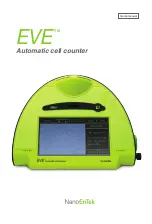
3
Instruction leaflet
IL05407002E
Effective October 2010
E5-648-C242x
electronic preset counter
with two presets
eaton corporation
www.eaton.com
1. preface
Please read this instruction manual carefully before installation
and start-up. Please observe all warnings and advice, both for
your own safety and for general plant safety. If the device is not
used in accordance with this instruction manual, then the intended
protection can be impaired.
2. Safety instructions and warnings
Please use the device only if its technical condition is perfect. It
should be used only for its intended purpose. Please bear in mind
safety aspects and potential dangers and adhere to the operating
instructions at all times.
2.1 Use according to the intended purpose
The preset counter detects and measures pulses, times and
frequencies up to max. 60 kHz and offers a wide variety of
different operating modes. At the same time, the preset counter
processes programmed presets. Use for any purpose over and
beyond this will be deemed as not in accordance with its intended
purpose and thus not complying with the requirements.
The application area for this device lies in industrial processes
and controls, in the fields of manufacturing lines for the metal,
wood, plastics, paper, glass, textile and other like industries.
Over-voltages at the terminals of the device must be kept within
the limits of overvoltage Category II.
The device must only be operated when mounted in a panel in the
correct way and in accordance with the section
Technical Data
.
Correct operation of the device requires the mandatory use
of the appropriate external safety fuse. Advice concerning the
recommended fuse-protection can be found under
Technical Data
.
The device is not suitable for use in hazardous areas and for areas
excluded in EN 61010 Part 1.
If the device is used to monitor machines or processes in which,
in the event of a failure of the device or an error made by the
operator, there might be the risk of damaging the machine or
causing an accident to the operators, then it is your responsibility
to take the appropriate safety measures.
2.2 Mounting in a control panel
CAUTION!
MOUNT The devICe AwAy frOM heAT sOUrCes ANd AvOId dIreCT
CONTACT wITh COrrOsIve lIqUIds, hOT sTeAM Or sIMIlAr.
Mounting instructions
1.
Remove mounting clip from the device.
2.
Insert the device from the front into the panel cut-out,
ensuring the front-panel gasket is correctly seated.
3.
Slide the fixing clip from the rear onto the housing, until the
spring clamps are under tension and the upper and lower
latching lugs have snapped into place.
2.3 Electrical installation
dANGer!
The devICe MUsT be dIsCONNeCTed frOM The pOwer sUpply,
befOre ANy INsTAllATION Or MAINTeNANCe wOrk Is CArrIed
OUT. AC-pOwered devICes MUsT ONly be CONNeCTed TO The
lOw-vOlTAGe NeTwOrk vIA A swITCh Or CIrCUIT breAker.
INsTAllATION Or MAINTeNANCe wOrk MUsT ONly be CArrIed
OUT by qUAlIfIed persONNel.
Advice on noise immunity
All connections are protected against external sources of
interference. The installation location should be chosen so that
inductive or capacitive interference does not affect the device
or its connecting lines! Interference (e.g. from switch-mode
power supplies, motors, clocked controllers or contactors) can be
reduced by means of appropriate cable routing and wiring.
Measures to be taken:
•
Use only shielded cable for signal and control lines.
Connect cable shield at both ends
•
The conductor cross-section of the cables should be
a minimum of 0.4 mm²
•
The shield connection to the equipotential bonding should
be as short as possible and with a contact area as large
as possible (low-impedance)
•
Only connect the shields to the control panel, if the latter
is also earthed
•
Install the device as far away as possible from
noise-containing cables
•
Avoid routing signal or control cables parallel to power lines.
•
Cables and their insulation should be in accordance with the
intended temperature and voltage ranges
3. Description
•
Six-digit multifunction LCD display
•
Easy-to-read two-line LCD-display with annunciators for both the
displayed preset and the status of the two outputs
•
Simultaneous display of the actual value and of the presets or
auxiliary counters
•
Add./Sub. preset counter with two presets
•
Relay outputs
•
Easy-to-program
•
Simple preset entry via the front keys or via the
Teach-In
function
•
Step or tracking preset
•
Pulse, frequency, time or batch counter
•
Preset counter, Batch counter or Total counter
(cumulative count)
•
Set function for pulse and time counter
•
Multiplication and division factor (00.0001–99.9999)
for pulse counter and frequency meter
•
Averaging and start delay for frequency meter
•
Input modes:
•
Pulse counter: cnt.dir, up.dn, up.up, quad, quad2, quad4,
A/B, (A-B)/Ax100%
•
Frequency meter: A, A – B, A + B, quad, A/B, (A-B)/Ax100%
•
Timer: FrErun, Auto, InpA.InpB, InpB.InpB
•
Output operations: Add, Sub, AddAr, SubAr, AddBat,
SubBat, AddTot, SubTot, Trail, TrailAr
•
Four-stage RESET-Mode
•
Three-stage keypad locking (Lock)
•
MPI input for Display Latch, Teach-In function or Set function
•
Supply voltage 90–260 Vac or 10–30 Vdc
Downloaded from
Elcodis.com
electronic components distributor




































